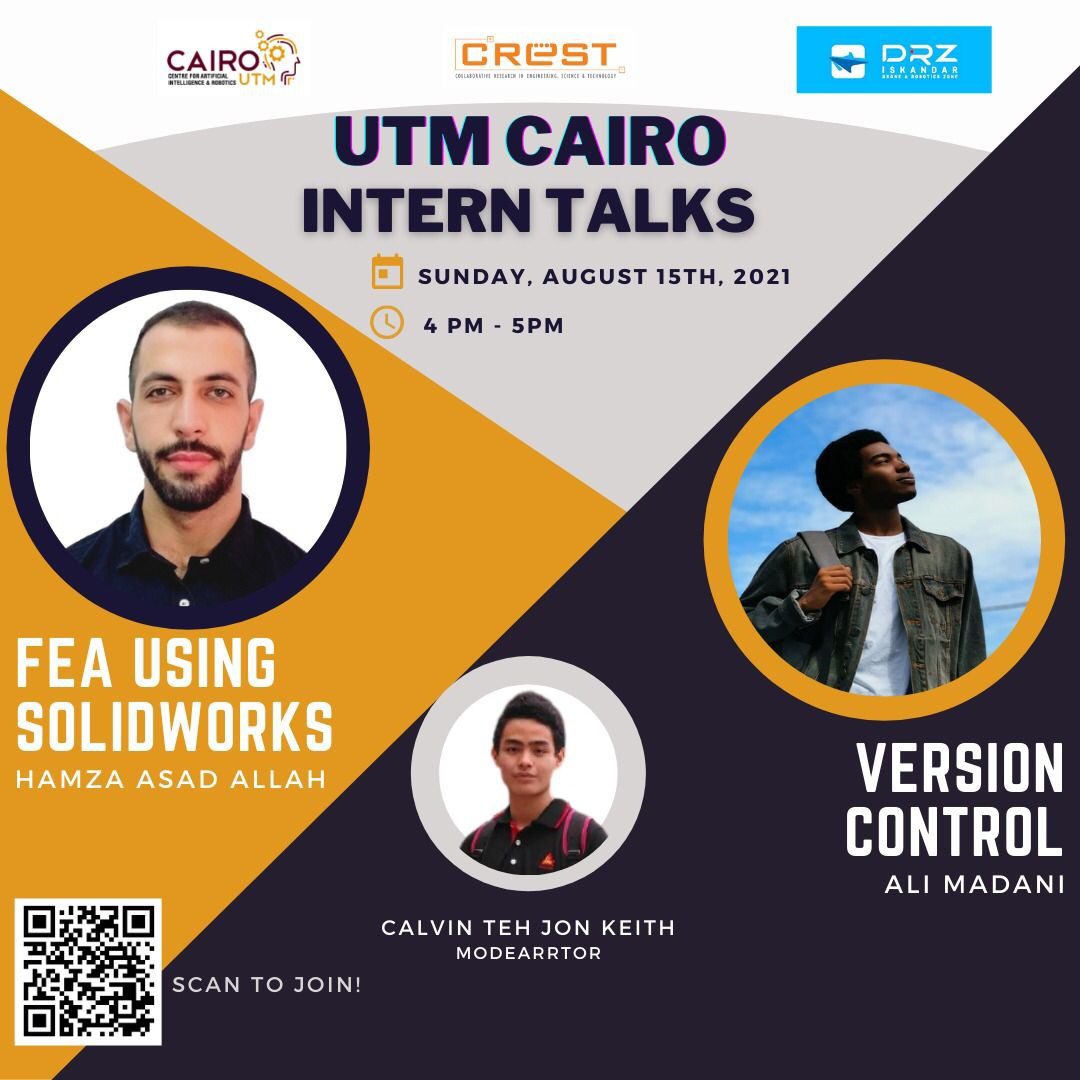Authored by: Calvin Teh Jon Keith, Shafishuhaza Sahlan
The internal CAIRO UTM Interns webinar on Finite Element Analysis (FEA) Using SOLIDWORKS & Version Control, organised by CAIRO UTM Interns was delivered by Mr. Hamza Asad Allah and Mr. Ali Madani, respectively on 15th August 2021. Mr. Hamza and Mr. Ali are fellow interns undergoing industrial training in the Centre for Artificial Intelligence and Robotics (CAIRO), Universiti Teknologi Malaysia, UTM. The webinar was moderated by Mr. Calvin Teh Jon Keith, who is also a fellow intern in the CAIRO UTM Interns. The CAIRO UTM Interns is an industrial training group supervised by CAIRO UTM members, Associate Professor Dr Yeong Che Fai, and Ir. Dr Shafishuhaza Sahlan.
In the first session of the webinar, Mr Hamza talked on Finite Element Analysis (FEA) utilizing Computer Aided Drawing (CAD) software known as SOLIDWORKS. FEA is a process of simulating the behaviour of a part of assembly using finite element method (FEM). Mr. Hamza who is originally from Syria, graduated from Universiti Teknologi Malaysia in Manufacturing Engineering in June 2021 with two years’ experience as Design Engineer. During his study, Mr. hamza was involved in different projects under product development, and he is a member of the ASME Malaysian Chapter. Mr. Hamza best achievement was being awarded first place Winner in Collaborative Research in Engineering, Science and Technology (CREST) Healthcare Innovation Challenge for his product design in 2019.
Mr. Hamza began his talk by defining what FEA was and how it was being used in our daily application. According to Mr. Hamza, FEA is a numerical method for solving problems of engineering and mathematical physics. After explaining about a brief history of FEA he then proceeded to talk about three factors that are to be considered when it comes to FEA, as illustrated in Figure 1.
Figure 1
Mr. Hamza emphasized that time, cost, and quality are the important factors that every engineer need to consider when working with FEA. The goal was to prioritize the safety feature of the product. Mr. Hamza explained how FEA was used in stress analysis for trusses, beams and other simple structures that are carried out based on dramatic simplification and idealization. This design theory is based on the calculation results of the idealized structure and a large safety factor. Mr. Hamza then proceeded to name a wide range of fields where FEA are commonly applied which are civil, electrical mechanical and other engineering fields.
Hamza continued to explain about the discretization process starting from idealization of the mathematical models which simulates the behaviour of a system. This is then followed by discretization where Mr. Hamza talked about the finite difference discretization and finite element discretization. After that process, what’s left is the solution algorithm that must be generated.
In the elements for FEA, Mr. Hamza explained on five properties which are dimensionality, nodal points, geometry, degree of freedom and nodal forces. Before finalizing his session, Mr. Hamza then proceeded to show a brief demonstration from SOLIDWORKS, as depicted in Figure 2.
Figure 2
The second talk for the day was on version control, conveyed by Mr. Ali Madani. Mr. Ali explained that version control is a class of systems responsible for managing changes. Version control systems is a standalone application used to record changes made to software code and other documents. Mr. Ali then proceeded to mention about repositories which are defined where changes are stored in the form of snapshots or commits.
In the process of version control, Mr. Ali proceeded to talk about the flow of the system which started with the creation of new HTML files following by the addition of the title. These are then added with intro paragraphs which will be further changed. They will then be added a text body before proceeding with the creation of the cascading style sheet (CSS) file. The flow of how the snapshot is first taken and how it changes with every change made can be seen in Figure 3.
Figure 3
Mr. Ali then proceeded to talk about the types of version control system namely, local, centralized and distributed. Mr. Ali began to explain the differences in the types of version control and their industrial application. Mr. Ali then moved on to talk about the advantages of version control system (VCS) which are the ability to save backups, experimentation and traceability and collaboration. Mr. Ali then proceeded to show a few examples of branching, as shown in Figure 4.
Figure 4
The second part of Mr. Ali’s talk was on git and GitHub where he explained on how the distributed VCS works. Mr. Ali then began to introduce the eight basic git commands which he frequently used and how they are applied into GitHub. For more details about installation and documentation, account registration and more tutorials, please refer to the links below.
- For Git Installation & Documentation: https://git-scm.com/
- For GitHub account registration: https://github.com/
- For Git tutorials: https://www.atlassian.com/git/tutorials

